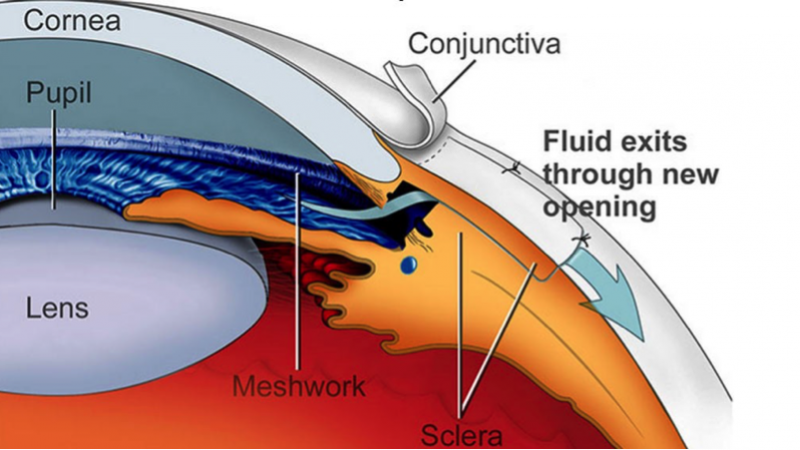Incisional Glaucoma Surgery
Traditional incisional surgical treatment for glaucoma is recommended after attempts with medications or lasers are unsuccessful If medical therapy for glaucoma is ineffective at halting the ongoing damage to the optic nerve and loss of vision, your eye doctor may recommend glaucoma surgery. There are many different types of surgery for glaucoma. Each one of them is performed in order to lower intraocular pressure. By lowering intraocular pressure, it is hoped that optic nerve damage and loss of vision can be halted. Surgery for glaucoma is performed in an ambulatory surgery center.
As with other treatments for the body, we strive to minimize the invasiveness of surgical intervention for glaucoma management. Over the past decade, we have been fortunate in that a number of micro-invasive glaucoma procedures (or MIGS) have become available to reduce eye pressure with a much lower degree of recovery and risk compared to older traditional glaucoma surgeries. The aim of MIGS is to enhance the eye’s natural outflow by manipulating various levels of the natural drainage system. Some MIGS procedures can only be performed in conjunction with cataract surgery, while others can be done before, after, or during cataract surgery. The eye and its drainage system are carefully examined in the clinic and the best procedure will be chosen to maximize results. Unfortunately, glaucoma surgery does not always work and some patients do require more than one procedure—regardless if one has a MIGS or traditional filtration procedure. Though MIGS procedures have a proven track record of success, there are times a procedure is performed that fail to yield the desired result of reducing one’s eye pressure. This is primarily due to advanced closure or disease of the drainage system that is unable to be rejuvenated with the surgical procedure. The best analogy is to think of patients that have heart disease and have stents placed in the heart’s arteries. Because arteries can be so clogged, stents sometimes fail to open the artery and a bypass procedure is needed. With traditional glaucoma filtration surgery, we bypass the eye’s natural drainage system and create a communication between the high-pressure cavity into a space between the white of the eye and the overlying skin called the conjunctiva. The eye views this passage as a traumatic wound and has a natural tendency to try to seal this wound off with scar tissue. Should the eye succeed in sealing off this passage, fluid will stop filtering and eyes pressure will again rise to pre-operative levels. As there is no cure for glaucoma and glaucoma treatment may fail over time, it is imperative that all patients continue to be monitored lifelong even if surgery has been performed.
Incisional Glaucoma Surgery
Traditional incisional surgical treatment for glaucoma is recommended after attempts with medications or lasers are unsuccessful If medical therapy for glaucoma is ineffective at halting the ongoing damage to the optic nerve and loss of vision, your eye doctor may recommend glaucoma surgery. There are many different types of surgery for glaucoma. Each one of them is performed in order to lower intraocular pressure. By lowering intraocular pressure, it is hoped that optic nerve damage and loss of vision can be halted. Surgery for glaucoma is performed in an ambulatory surgery center.
As with other treatments for the body, we strive to minimize the invasiveness of surgical intervention for glaucoma management. Over the past decade, we have been fortunate in that a number of micro-invasive glaucoma procedures (or MIGS) have become available to reduce eye pressure with a much lower degree of recovery and risk compared to older traditional glaucoma surgeries. The aim of MIGS is to enhance the eye’s natural outflow by manipulating various levels of the natural drainage system. Some MIGS procedures can only be performed in conjunction with cataract surgery, while others can be done before, after, or during cataract surgery. The eye and its drainage system are carefully examined in the clinic and the best procedure will be chosen to maximize results. Unfortunately, glaucoma surgery does not always work and some patients do require more than one procedure—regardless if one has a MIGS or traditional filtration procedure. Though MIGS procedures have a proven track record of success, there are times a procedure is performed that fail to yield the desired result of reducing one’s eye pressure. This is primarily due to advanced closure or disease of the drainage system that is unable to be rejuvenated with the surgical procedure. The best analogy is to think of patients that have heart disease and have stents placed in the heart’s arteries. Because arteries can be so clogged, stents sometimes fail to open the artery and a bypass procedure is needed. With traditional glaucoma filtration surgery, we bypass the eye’s natural drainage system and create a communication between the high-pressure cavity into a space between the white of the eye and the overlying skin called the conjunctiva. The eye views this passage as a traumatic wound and has a natural tendency to try to seal this wound off with scar tissue. Should the eye succeed in sealing off this passage, fluid will stop filtering and eyes pressure will again rise to pre-operative levels. As there is no cure for glaucoma and glaucoma treatment may fail over time, it is imperative that all patients continue to be monitored lifelong even if surgery has been performed.
Incisional Glaucoma Surgery
Traditional incisional surgical treatment for glaucoma is recommended after attempts with medications or lasers are unsuccessful If medical therapy for glaucoma is ineffective at halting the ongoing damage to the optic nerve and loss of vision, your eye doctor may recommend glaucoma surgery. There are many different types of surgery for glaucoma. Each one of them is performed in order to lower intraocular pressure. By lowering intraocular pressure, it is hoped that optic nerve damage and loss of vision can be halted. Surgery for glaucoma is performed in an ambulatory surgery center.
As with other treatments for the body, we strive to minimize the invasiveness of surgical intervention for glaucoma management. Over the past decade, we have been fortunate in that a number of micro-invasive glaucoma procedures (or MIGS) have become available to reduce eye pressure with a much lower degree of recovery and risk compared to older traditional glaucoma surgeries. The aim of MIGS is to enhance the eye’s natural outflow by manipulating various levels of the natural drainage system. Some MIGS procedures can only be performed in conjunction with cataract surgery, while others can be done before, after, or during cataract surgery. The eye and its drainage system are carefully examined in the clinic and the best procedure will be chosen to maximize results. Unfortunately, glaucoma surgery does not always work and some patients do require more than one procedure—regardless if one has a MIGS or traditional filtration procedure. Though MIGS procedures have a proven track record of success, there are times a procedure is performed that fail to yield the desired result of reducing one’s eye pressure. This is primarily due to advanced closure or disease of the drainage system that is unable to be rejuvenated with the surgical procedure. The best analogy is to think of patients that have heart disease and have stents placed in the heart’s arteries. Because arteries can be so clogged, stents sometimes fail to open the artery and a bypass procedure is needed. With traditional glaucoma filtration surgery, we bypass the eye’s natural drainage system and create a communication between the high-pressure cavity into a space between the white of the eye and the overlying skin called the conjunctiva. The eye views this passage as a traumatic wound and has a natural tendency to try to seal this wound off with scar tissue. Should the eye succeed in sealing off this passage, fluid will stop filtering and eyes pressure will again rise to pre-operative levels. As there is no cure for glaucoma and glaucoma treatment may fail over time, it is imperative that all patients continue to be monitored lifelong even if surgery has been performed.

Most commonly performed glaucoma procedures
and offered by surgeons at El Paso Eye Surgeons, P.A.
and offered by surgeons at El Paso Eye Surgeons, P.A.
Traditional filtration procedures
Presser Flow:
- Glaucoma Drainage Devices
- Ahmed drainage device
- Baerveldt drainage device
- Molteno drainage device
Micro-invasive Glaucoma Surgery
- Trabecular Microbybass Devices and Procedures
- Schlemm’s Canal Dilation Devices and Procedures
- ABiC or ab-interno canaloplasty using the iTrack catheter
- OMNI microsurgical device
- Goniotomy Devices and Procedures
- Kahook Dual Blade®
- Trabectome
- iTrack—GATT procedure or gonioscopy assisted transluminal trabeculectomy
- OMNI microsurgical device
- Cycloablation Procedures
Two Goals of
Incisional Glaucoma Surgery
Incisional Glaucoma Surgery
This usually involves surgery in an operating room facility. All glaucoma surgeries are day surgeries performed in an ambulatory surgery center. During the surgery, your ophthalmologist makes tiny cuts, also known as incisions, into the outer or inner layers of the eye with a tiny knife while looking through a microscope. It involves plenty of tiny sutures to keep the tissues of your eye together. It is not uncommon to feel these sutures in the early post-operative period.
You will meet with a preoperative scheduling nurse prior to your surgery, who will provide you with detailed instructions on how to prepare yourself for your upcoming eye surgery. You will need to report at your allocated time to the surgery center. You are not to eat or drink anything after midnight prior to the day of your surgery. You can take your regular pills with a limited amount of water (not juice or milk) the morning of surgery.
The goal of incisional glaucoma surgery is to improve drainage of intraocular fluid (aqueous humor). This can be accomplished in two ways:
-
- Improving the drainage of aqueous into its natural physiological pathway. This involves finding and working in Schlemm’s canal (Canaloplasty, Trabectome®)
- Creating a bypass channel, for fluid to flow from within the eye to pass unimpeded into the outer layers of the eye, Aqueous bypasses trabecular meshwork( the tiny drain within the eye) which is impaired in glaucoma. The new bypass channel can be created using natural tissues of the eye (Trabeculectomy,Express® glaucoma mini shunt and the Xen45 gel stent) or by using a silicone tube implant Glaucoma Drainage Implants (Ahmed or Baerveldt).
Sometimes your doctor may suggest combining these surgeries with Cataract Surgery to help improve your vision. Occasionally cataract surgery alone may be recommended for treatment of your glaucoma. Whenever cataract surgery is performed, a replacement intraocular lens implant (IOL) is always placed within your eye at the time of surgery. Currently there is a choice of intraocular lens implants available and your doctor will help pick the right IOL for you based upon the measurements of your eye, your visual needs and your stage of glaucoma. The intraocular lens implants available are Multifocal lens implants, Toric lens implants and Monofocal lens implants. Feel free to discuss these lens options with your doctor or technicians during your appointment or after to see if you are a candidate for one of these implants.
Your doctor will discuss your surgical options with you and recommend the appropriate procedure at the time of your appointment. When successful, these procedures lower intraocular pressure and preserve vision.

Contact Our Office to
Learn More
Learn More

